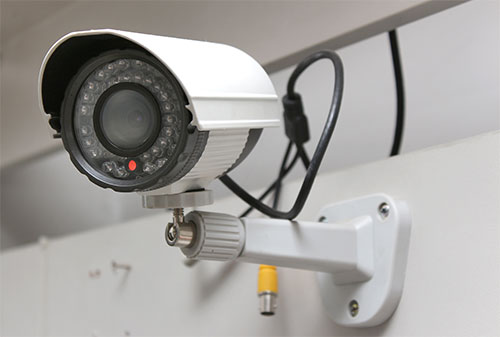 Online banking. ATMs. EFT. What do all these activities have in common? They all rely on a robust network infrastructure to ensure dependable performance. So, if that solid, proven foundation is already in place, why are so many financial institutions still stuck in the Analog Age when it comes to their video surveillance?
Online banking. ATMs. EFT. What do all these activities have in common? They all rely on a robust network infrastructure to ensure dependable performance. So, if that solid, proven foundation is already in place, why are so many financial institutions still stuck in the Analog Age when it comes to their video surveillance?
A lot of the reluctance to migrating to IP-based surveillance is based on misconception. I often hear of IT managers telling their corporate security managers that deploying IP video across the enterprise will eat up too much bandwidth. However, this doesn’t have to be the case. With judicious use of advanced video compression technology like H.264, edge-based data processing and analytics, and other sophisticated video management tools, users can achieve tighter control of bandwidth consumption and minimize the impact of video traffic on the network.
But, is making the move to IP video really worth the effort? The answer to that question is an emphatic “yes.” Compared to analog, IP video technology provides the fastest return on investment by taking immediate advantage of an existing IP infrastructure. IP cameras plug into the network like any other peripheral device, so you don’t need to string miles of coax cable. You don’t have to settle for grainy, indistinct images either. The video you capture is generally of a much higher resolution, providing a wealth of detail often missing from legacy analog systems. However, the real payoff comes from the value you can derive from the additional functionality of the cameras once they’re installed
Securing Teller and ATM Transactions
With many financial institutions considering the replacement of live tellers with ATMs, the boundaries between physical security and transaction security start to blur. Because IP video is network-based, it can provide that crucial visual link between transaction data, customers, tellers and ATMs. Cameras can be programmed to record on motion and video can be tagged to enable security professionals to quickly retrieve specific clips by transaction record as well as time and location.
It’s all part of an overarching theme to drive down operating costs without sacrificing customer service.
ATMs allow customers with simple deposit and withdrawal needs to bank more quickly, while freeing live tellers to handle more complex customer interactions. IP video keeps a watchful eye on the whole operation, which can be a useful deterrent to temptation. When coupled with sophisticated video search programs, IP video can also save significant man-hours by shortening the retrieval time to extract pertinent forensic evidence to aid law enforcement during investigations.
Leveraging an Intelligent Edge
Many of today's IP video cameras are built with powerful internal processors that not only deliver HD-quality video images, but also have the capacity to run video analytics and other onboard applications. The increased processing power out at the edge means video data can be processed locally, resulting in less traffic on the network. It also means that IP technology can help do some of the heavy lifting previously done by security guards staring at video monitors for hours on end. Studies show that after 20 minutes of active viewing the human brain tends to “zone out” and miss crucial event details, but IP video cameras never do. The continual vigilance IP video delivers can pay huge dividends for organizations tasked to make more efficient use of shrinking security budgets.
Beyond programmable tools to minimize network traffic, numerous advanced IP video cameras take full advantage of their greater onboard processing power to support an array of in-camera analytics software. Many of these applications focus on gathering critical data that can provide valuable business intelligence reports to other departments besides physical security. With proactive use, this data can yield important insights into day-to-day operations that might otherwise have gone unnoticed, exposing issues that left unchecked could potentially have a negative impact on the financial institution’s bottom line.
Flagging problems in real-time. Some analytics can detect someone loitering in an ATM vestibule and send text or audio alerts to security to immediately investigate. Other analytics count people in a teller line, data that management can use to fine-tune their staffing requirements and improve the customer experience. While still other analytics expedite video searches for fraud incidents based on a specific criteria or transaction amount.
Multi-purposing technology. Once the IP cameras are in place, financial institutions can leverage the technology for other purposes as well, like video conferencing between branches and training new hires with real-time feedback on their mastery of company policies and procedures.
Determining the Full Value Proposition
To determine whether the capital outlay for IP video is worth the investment, let’s look at the true cost of the technology and the real return on investment that it offers compared to its analog predecessor.
The core components of a traditional analog solution include:
- Camera;
- Camera power supply;
- DVRs:
- Coax cable; and
- Installation labor.
The core components of an IP solution include:
- Camera;
- PoE switches;
- Network storage; and
- Network infrastructure.
Based on component costs alone, a traditional analog solution may seem like a more cost-effective option. But if your goal is to leverage your existing network infrastructure and lay the groundwork for future scalability, IP video is the smarter investment for the long term. Here’s why:
In an analog solution, expansion costs are determined by the number of video ports available on the DVR. If you have maxed out your 4-, 8-, or 16-channel DVR and you only need to add one more camera, you have to purchase another DVR. And, along with the expense of a second DVR comes the associated material and labor costs of installing more cable runs as well as the disruption to daily operations while a technician strings the cable. Or, you can pay a premium to have the technician do the work after hours. DVRs are proprietary systems that limit your choice of cameras and software capabilities. There’s also the issue of longevity. In an analog system, you can generally expect to replace the DVR component at least twice before the cameras reach their end of life.
On the other hand, an IP system relies on infrastructure that’s already in place for other banking activity, which can represent a significant cost savings for the overall project. IP technology is also easier to install and maintain because you can fine-tune the cameras – from focus and field-of-view (FOV) to other parameters like resolution and frames per second – as well as perform diagnostics and firmware upgrades remotely, which saves the cost of repeated onsite service calls. By removing DVRs from the equation, you eliminate the single most common point of failure from the system. The net result is improved uptime and improved reliability across the board.
From an expansion perspective, IP video is more cost-effective to scale because you purchase only as much as you need at a given point in time. You can start with one or two cameras at a new branch office and if you decide at a later date the location needs more coverage, you can add cameras to the site in any increment you choose.
Cost issues aside, the bottom line is that IP video delivers much improved image quality, which is critical in determining the details of any incident. With HD resolution and the ability for many IP cameras to operate in horizontal and vertical (corridor format), you get greater location coverage than you could achieve with analog technology.
Because IP video is based on open standards, you can now choose among best-of-breed components and third-party software that can address your specific banking environment needs. For instance, you can select cameras with SD cards for primary or backup storage and embed analytics in the cameras for motion detection, cross line detection, people counting and queue monitoring, among other analytics, in order to learn more about daily operations.
Once you lay out all these arguments side by side, it becomes obvious that IP video offers the banking industry a better value proposition in overall cost of ownership, versatility, usability and future growth.